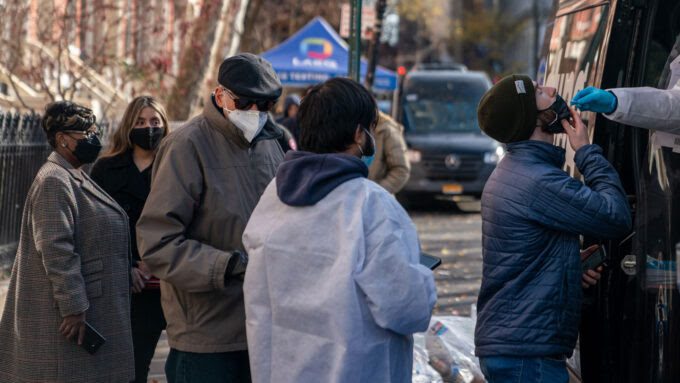Antibodies that neutralize omicron and other SARS-CoV-2 variants have been discovered by an international team of experts. These antibodies attack parts of the virus spike protein that don’t change much while the viruses evolve.
According to David Veesler, an investigator with the Howard Hughes Medical Institute and associate professor of biochemistry at the University of Washington School of Medicine in Seattle, identifying the targets of these “broadly neutralizing” antibodies on the spike protein could lead to the development of vaccines and antibody treatments that are effective against not only the omicron variant but other variants that may emerge in the future. “This discovery suggests that by focusing on antibodies that target these highly conserved regions on the spike protein, we can combat the virus’s ongoing evolution,” Veesler said.
Veesler co-led the study in Switzerland with Davide Corti of Humabs Biomed SA, Vir Biotechnology. The findings of the study were published in the journal Nature on December 23. Elisabetta Cameroni and Christian Saliba (Humabs), John E. Bowen (UW Biochemistry), and Laura Rosen (Humabs) were the study’s lead authors (Vir).
Read also: Buhari congratulates Christopher Kolade, the former High Commissioner to the United Kingdom, on his 89th birthday
The spike protein, which the omicron version utilizes to attach onto and infiltrate cells, has 37 mutations. This is a disproportionately large number of mutations. These alterations are expected to explain why the variety has been able to spread so quickly, infecting persons who have been vaccinated as well as reinfecting those who have already been infected.
“The main questions we were trying to answer were: how has this constellation of mutations in the omicron variant’s spike protein affected its ability to bind to cells and evade antibody responses from the immune system?” Veesler said.
[Veesler and his colleagues suspect that omicron’s enormous number of mutations occurred over time in someone with a weaker immune system or as a result of the virus moving from people to animals and back.]
To test the impact of these alterations, the researchers created a pseudovirus, which is a crippled, nonreplicating virus that produces spike proteins on its surface, similar to coronaviruses. They then created pseudoviruses with spike proteins containing omicron mutations, similar to those found in the pandemic’s earliest variants.
The researchers initially tested how effectively several forms of the spike protein bind to a protein on the cell surface that the virus uses to grip onto and enter the cell. The angiotensin converting enzyme-2 (ACE2) receptor is the name of this protein.
They discovered that the omicron variant spike protein was 2.4 times better at binding than the spike protein present in the virus isolated at the start of the pandemic. “That’s not a significant increase,” Veesler said, “but changes in the spike protein that boosted affinity were related with higher transmissibility and infectivity during the SARS pandemic in 2002-2003.” They also discovered that the omicron version could effectively bind to mouse ACE2 receptors, implying that omicron could “ping-pong” between humans and other mammals.
Read also: Bandits kidnapped around 30 women
The researchers then looked at how well antibodies developed against earlier strains of the virus protected them from the omicron variety. They achieved this by utilizing antibodies from patients who had previously been infected with earlier forms of the virus, had been vaccinated against earlier strains of the virus, or had been infected and then vaccinated against earlier strains of the virus.
They discovered that antibodies from people who had been infected by earlier strains, as well as those who had received one of the six most often used vaccines, all had a reduced ability to prevent infection.
Antibodies from previously infected patients, as well as those who had received the Sputnik V or Sinopharm vaccines, as well as a single dose of Johnson & Johnson, had little or no ability to inhibit – or “neutralize” – the omicron variant’s entry into cells. Antibodies from patients who received two doses of the Moderna, Pfizer/BioNTech, and AstraZeneca vaccines preserved some neutralizing action, albeit at a considerably lower level than any other variety.
Antibodies from patients who had been sick, recovered, and then received two doses of vaccine had lower activity, around fivefold, suggesting that immunization after illness is beneficial.
Antibodies from people who had received a booster with a third dose of the mRNA vaccines produced by Moderna and Pfizer/BioNTech showed only a 4-fold reduction in neutralizing activity, in this case a group of renal dialysis patients. “This demonstrates that a third dose is quite beneficial in the fight against omicron,” Veesler added.
In the laboratory, all but one of the antibody therapies currently permitted or approved for use with individuals who have been exposed to the virus had no or significantly decreased effectiveness against omicron. The exception, according to the study, was an antibody called sotrovimab, which exhibited a two- to three-fold decline in neutralizing activity.
The researchers discovered four classes of antibodies that preserved their ability to neutralize omicron when they evaluated a larger panel of antibodies that had been created against prior generations of the virus. SARS-CoV-2 variations, as well as a group of related coronaviruses known as sarbecoviruses, have members of each of these classes that target one of four distinct regions of the spike protein. These protein sites may remain because they serve an important function that would be lost if they mutated. The term “conserved” refers to such places.
The fact that antibodies can kill so many different variations of the virus by recognizing conserved sections suggests that creating vaccines and antibody treatments that target these regions could be successful against a wide range of variants that emerge through mutation, according to Veesler.
Fast Grants, the Pew Charitable Trust, The Burroughs Wellcome Fund, the Center for Research on Influenza Pathogenesis (75N93021C00014), the Japan Agency for Medical Research and Development (JP21wm0125002), the Howard Hughes Medical Institute, the National Institute of Allergy and Infectious Diseases (Dp1AI158186, HHSN272201700059C, HHSN272201400008C), the National Institute of General Medical
Join Television Nigerian Whatsapp Now
Join Television Nigerian Facebook Now
Join Television Nigerian Twitter Now
Join Television Nigerian YouTUbe Now

























